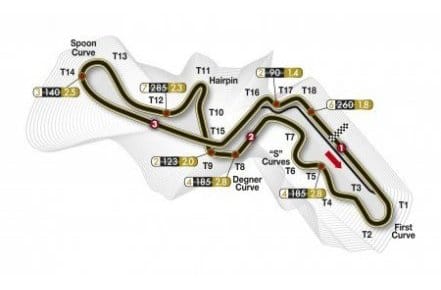
F1weekly and Renault Sport F1 preview to the Japanese GP
The FIA Formula One World Championship remains in the Far East for round 15 of the 19 race calendar; the Japanese Grand Prix.
The race is held at the famed Suzuka Circuit, a high-speed figure of eight track that features every possible corner, from high speed kinks to flowing linked turns and profiled curved bends and chicanes and hairpins. As such, it’s a tough challenge for the Renault RS27 engine that needs to deliver across the entire power spectrum without sacrificing driveability and responsiveness.
Japanese Grand Prix facts and figures
– This is one of the toughest circuits of the year for the RS27 engine, after Spa and Monza. The engine needs to be strong throughout the rev range, plus give good driveability and responsiveness to handle the numerous corners.
– Suzuka is a circuit of two halves. The first part of the circuit, from the First Curve to Spoon Curve, is flowing and contains 75% of the circuit’s corners. The engine needs to be driveable and smooth throughout the power curve in this part. The second half of the track, from the exit of Spoon to the end of the pit straight, is all about outright power as 90% of this section is spent at full throttle.
– The awesome 130R corner, a curved straight, is taken at nearly 310kph with high lateral G-forces. This long straight is a huge 1250m from the exit of turn 14 and is only interrupted by the chicane leading onto the pit straight. Drivers will brake down from 320kph to under 100kph for this chicane, but will accelerate back up to 320kph down the 900m pit straight.
– The rapid changes of direction through the Esses – the series of interlinking corners from turns 3 to 7 – require ultimate driveability and responsiveness. The driver will enter turn 3 at approximately 245kph and carry the speed through until exiting the complex. Gear selection here is crucial as the driver will spend approximately 15secs in fourth or fifth gear through this section.
– The weather in Japan can be very changeable. In 2010 sunshine gave way to heavy rain on Saturday, which led to the qualifying being delayed until Sunday morning. To allow flexibility, the engine maps may need to be compromised between wet and dry settings, particularly with the ban on changing settings between qualifying and the race.
Heikki Kovalainen, Team Lotus
Japan is a circuit I really look forward to. I’ve had some memorable results there, including second in 2007 with the Renault F1 Team, but every time we go there it’s a pleasure to drive the circuit and the atmosphere is incredible. Every driver loves the track as you need to be 100% committed through the lap to attack every one of the corners. This means you have to have confidence in your set-up and a good engine is crucial. It’s not easy to get the right maps as we need good top end power to negotiate the faster corners, such as the 130R, where we’ll be going at nearly 300kph on the apex and over 320kph by the entrance to the chicane. However we also need traction through the flowing corners in the first sector, including the Esses where we’ll be carrying about 250kph through the whole complex. From what we’ve seen on similar circuits, such as Canada and Australia, the RS27 delivers on the levels we need it to, and I’ll be working with my engine engineer to optimise settings for max driveability here.
Head of Renault Sport F1 track operations Rémi Taffin gives his thoughts on Japan:
Japan is a particularly demanding track on engines and one of the hardest to prepare. Only Spa and Monza beat it on the percentage of outright engine power required through the lap. Like Spa, the RS27 needs to deliver good top end power, particularly through the second part of the circuit from Spoon through the 130R to the chicane, but also traction, driveability and responsiveness through the medium to low speed turns in the first section. As such, it’s one of the tracks that we will use to check reliability on the dyno as the engine gets such a thorough workout!
The high speed corners such as the Esses also subject the internals of the engine and lubricant systems to high lateral G-forces so we monitor reliability very carefully and may introduce new units this weekend to give optimal reliability and power.
It’s a special weekend for Renault Sport F1 as we could see Sebastian Vettel secure the drivers’ title. Eight drivers have previously won the title with a Renault engine and each has been warmly welcomed back at Viry. A lot of hard work goes into providing the most competitive engine for our teams and everyone takes the same amount of pride in the title as our partners at Red Bull. To win the title in Japan in front of our colleagues in the Renault-Nissan alliance would also be a great boost after the challenges of the earthquake and tsunami disaster earlier this year.
Sebastian Vettel needs just one more point to win the drivers’ championship in Japan. If he does so, the title will be the ninth time a Renault engine has powered a driver to the crown. The first came in 1992 with Nigel Mansell (Williams-Renault), followed in 1993 with Alain Prost (Williams-Renault). Michael Schumacher won with Benetton-Renault in 1995, with Williams-Renault taking the title in 1996 and 1997 with Damon Hill and Jacques Villeneuve respectively. Fernando Alonso took the title in 2005 and 2006 with the Renault F1 Team before Vettel again sealed the win last season.
